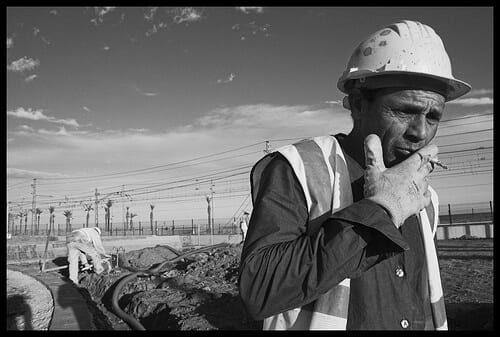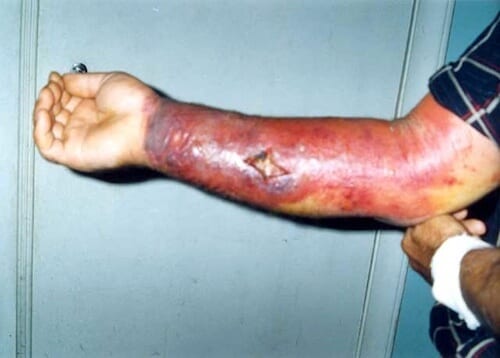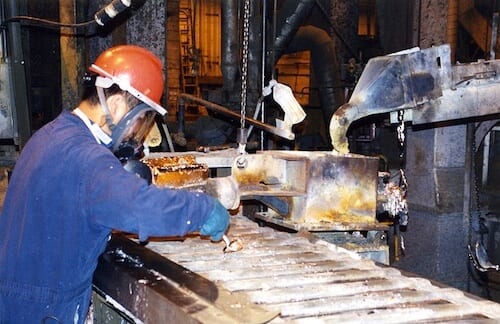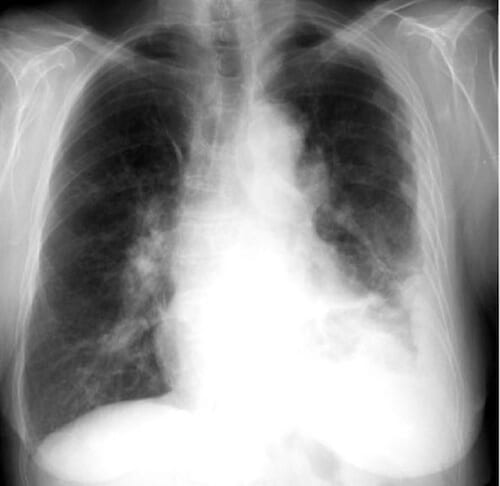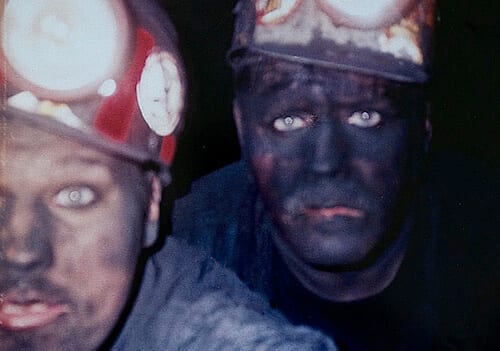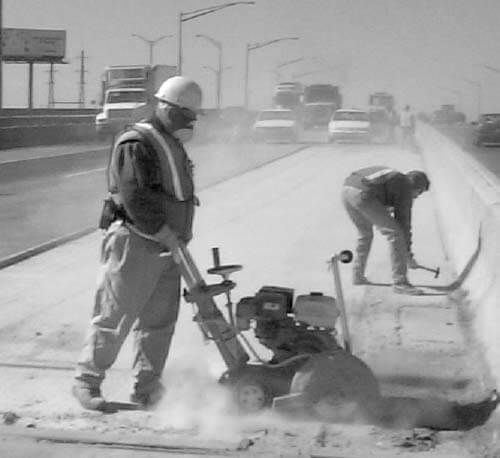The world of work is full of surprises. The modern job market, for example, can take a candidate into areas where they undertake many unusual and unexpected activities. However, most of the time, present-day job seekers can at least count on being safe and not at risk from serious illness. Or can they? Throughout history, not everyone has been so lucky.
While the closest most of us get to occupational disease is a brush with carpal tunnel syndrome, we’ll soon see that there is a fascinating and disturbing assortment of illnesses and diseases that have made hay in the workplace – particularly in times past. Definitely not for the squeamish, what follows is a look through the murky world of work-related illness.
10. Chimney Sweep’s Carcinoma
Chimney Sweeps’ carcinoma, also known as Soot wart, is a form of skin cancer affecting the scrotum. Its name derives from the fact that it was first noted occurring among chimney sweeps – young men in their late teens and early twenties who had worked with soot for most of their lives. The disease was first identified in 1775 by Sir Percivall Pott, an English surgeon, and one of the first scientists to theorize on the link between cancers and environmental hazards. The disease into which Pott researched proved fatal if it was not treated. Left unchecked, the warts developed into a scrotal cancer that would make the testicles balloon in size before invading the abdomen with deadly effect. The only treatment available to medics at the time was surgery – cutting out the diseased flesh – a terrifying prospect for the young sweeps. The true cause of the disease was not proven until 1922, when carcinogens were discovered in soot.
9. Phossy Jaw
Phossy jaw, also known as phosphorus necrosis of the jaw, was most commonly seen among match workers in the 19th and early 20th centuries – famously, the “London matchgirls,” whose strike of 1888 brought the problem into the public eye. In those days, matches were made with white phosphorus, and prolonged exposure to the vapor of the substance caused deposits to form in the victims’ jawbones. Throbbing toothaches, extreme swelling of the gums and abscesses in the jawbone followed. The afflicted bones would also take on a green-white tinge, while severe brain damage also lay in wait for those already suffering. The only known treatment was to surgically remove the jawbones; if it were left unchecked, organ failure and death would result. The disease also caused tremendous pain and disfigurement, and the rotting bone tissue emitted a putrid-smelling discharge. Phossy jaw did not begin to decline until 1906, when the use of white phosphorus was officially banned.
8. Radium Jaw
Radium jaw was a particularly unpleasant affliction that affected the so-called “Radium Girls” of the early 20th century. These workers were in the employment of the United States Radium Corporation, which enjoyed no small success with the production of its glow-in-the-dark radioactive paint. The paint, known by the trademark Undark, used radium as its chief ingredient. Unfortunately for the employees, they were told to lick the brushes they were using, the pointed tips of which were useful for painting fine details on clock faces or watches – but not so beneficial for the girls’ health. A painful swelling, bleeding and porosity of the jaws would follow, and ultimately, so too would death. Although radiation necrosis was initially denied by the company, the negative publicity created by the many cases of severe illness and death could not be ignored forever. Relatively simple worker safety laws were put in place and the outbreaks of radiation sickness eventually stopped altogether. The tragedy is that so many of these deaths were eminently preventable.
7. Byssinosis
Also known by the somewhat poetic name “Monday fever” – as well as the not-so-poetic “brown lung disease” – byssinosis is primarily associated with textile workers, especially young girls working in factories or mills. It is thought that exposure to cotton dust in poorly ventilated environments leads to the disease and its accompanying symptoms – namely, tightness of the chest, coughing and breathing difficulties. Experts believe the cause to be endotoxins from certain bacteria growing on the cotton. In extreme cases, the disease results in scarring of the lungs and, ultimately, death. During the 1990s, there were 81 bysinosis-related deaths in the United States alone. Such figures would likely have been much higher around the time of the industrial revolution, when cotton and fabric production increased dramatically throughout the world.
6. Anthrax
Anthrax, which often affects grazing animals, is caused by a type of bacteria, and most forms of this acute disease can be fatal to humans. Ingestion, inhalation and direct contact are all paths to infection and, for some workers, contracting the disease is a distinct possibility – particularly in countries where it is common. Many people who deal with dead animals or their skin and meat are exposed to anthrax spores, but most of the time the levels are not high enough for the full-blown disease to develop. However, when anthrax does develop fully, the results can be devastating. This was the case in April 1979, when the town of Sverdlovsk (now Ekaterinburg) in the then-Soviet Union was exposed to an anthrax leak from a nearby bio-weapons facility. It is thought that the accident caused the infection of at least 94 people, 68 of whom died. An extensive cover-up operation was undertaken before Russian President Boris Yeltsin eventually admitted to the disaster in 1992.
5. Asbestosis
Asbestosis is an inflammatory condition affecting the lungs that is directly caused by breathing in asbestos fibers. It often occurs among workers exposed to high levels of the dangerous mineral, or those dealing with it over an extended time period. The most obvious symptoms of asbestosis are shortness of breath and, in extreme cases, respiratory failure. Sufferers also face a greater risk of contracting lung cancer, not to mention mesothelioma (see entry 3). It can take several decades for the condition to manifest itself – but for people working in the mining, removal or manufacture of products containing asbestos, by then it may be too late. The disease is essentially characterized by scarring of the lung tissue by asbestos fibers, and at present there is no known curative treatment. In the worst cases, asbestosis can prove to be fatal.
4. Lead Poisoning
Lead poisoning is a potentially deadly medical condition caused by high levels of the eponymous toxic heavy metal in the body. Symptoms range from anemia and headaches to seizures, coma and death. Unfortunately for workers, occupational exposure is the main reason lead poisoning affects adults. Moreover, it has been estimated by the National Institute for Occupational Safety and Health that, in the US alone, over 3 million people could be exposed to lead while at work. Such exposure might occur in a myriad of ways: factory workers producing products containing lead, lead miners, plumbers, glass manufacturers, welders, printers and those involved in many more industries are all at risk. Lead poisoning was one of the first known environmental hazards. The metal was discovered around 6500 BC and its harmful effects were noted by as early as the 2nd century BC. Yet it can still cause illness and death even today.
3. Mesothelioma
Mesothelioma is a cancer that arises in the mesothelium, the protective membrane covering several of the body’s organs. The majority of people who fall victim have worked in occupations that expose them to asbestos and the inhalation of asbestos fibers. The disease, which can take between 20 and 50 years to appear, is identified by various symptoms, including chest pain, fatigue, neck or facial swelling, and in severe cases blood clots, jaundice and internal bleeding. The dangers of exposure to asbestos were identified in the early 20th century, but this did not prevent the ongoing risk of mesothelioma to workers around the world. In Western Australia, the deaths of over 500 people from the disease appear to be linked with asbestos mining that took place between 1945 and 1966. And in recent years – from 1980 to the late 1990s – the number of people dying from the disease went up from 2,000 a year to 3,000 in the US alone. Many buildings built before asbestos was banned may contain it, and renovators and builders should proceed with caution.
2. Coalworker’s Pneumoconiosis
Coalworker’s pneumoconiosis (CWP), widely known as “black lung disease,” is another killer. Mentioned in the same breath both as silicosis (see entry 1) and Caplan’s syndrome (a lung condition caused by exposure to coal, asbestos or silica dust), CWP is brought about by long-term exposure to and inhalation of coal dust. It can lead to inflammation and in extreme cases the death of cells in living tissue (necrosis). Despite the fact that mining conditions have improved dramatically in recent times, 10,000 American miners have died from CWP in the last decade alone – an astonishing 7.5 percent of the country’s active underground coal miners. What’s more, rates of black lung disease are actually on the increase, nearly doubling over the past decade. In an effort to tackle the problem, The National Institute for Occupational Safety and Health is currently offering miners a health evaluation every five years. Whether this measure is enough remains to be seen.
1. Silicosis
Silicosis, also known as Potter’s rot, has the dubious distinction of being the most widespread occupational lung disease. It affects people the world over but is more prevalent among workers in developing countries. Directly caused by the breathing in of crystalline silica dust, it inflames and scars the lungs’ upper lobes. Alarmingly, from the early to mid-‘90s, each year, China recorded over 24,000 fatalities as a result of the disease – the telltale signs of which include coughing, fever and shortness of breath. Respiratory problems from the inhalation of dust have been acknowledged since at least Ancient Greek times, but of course, with industrialization, the problem only worsened. There is no known cure for silicosis; treatments instead focus on symptom-relief and reducing exposure to any lung irritants. The use of respirators has brought the mortality rate down in the United States, but silicosis remains an ever-present danger for others in the less developed world – from silver miners in Bolivia to denim sandblasters in Turkey.
Related Resource: Is an HR Degree Worth It?
